Story by Bruce Bourquin í11 | Images by Kelly Lacefield
Warm scents of roses, pineapple guava, blue hibiscus and tulips mingle to invade the senses as visitors first enter the Fullerton Arboretum at Cal State Fullerton. Passing through the recently renovated entrance, by a roaring waterfall and into the grounds, visitors are greeted by a winding stream and garden trails.
From the older fruit trees, such as oranges and avocados, to the recently added Mojave exhibit, the arboretum offers more than 4,000 species of plants. Visitors can enjoy a green forest retreat, children’s garden, lake and rose garden; as well as an herb garden, Chaparral Hill, the Channel Islands exhibit, the orchard, the dry palm grove, and trees like redwoods, palms and figs.
Throughout the Fullerton Arboretum, visitors can see ducks, fish and turtles and other wildlife, including many bird species. Strolling through the four different plant collections on 26 acres is a treat for the senses. But it is not the only activity available at the arboretum, which was established in 1979 and recently celebrated its 30th anniversary.
“People say we’re one of the best-kept secrets on this campus,” said Greg Dyment, director of the Fullerton Arboretum. “We’re not trying to be its best-kept secret. There’s a lot to do here.” The arboretum attracts about 120,000 visitors and raises more than $200,000 in donations annually.
Visitors can experience a museum on the grounds, participate in classes, attend annual plant-related events, partake in nature walks the second Saturday of each month, volunteer in support of the arboretum and tour a historic 1890s home.
Mary Haller, who has volunteered at the arboretum for more than 10 years, works with the Nature Center, which serves as an educational hub for children and adults. On weekends, it becomes an informal visitor’s and information center. Children find a place to do things like color, play with puzzles, read or examine specimens from the arboretum.
“It’s such a wonderful place, it’s a wholesome place,” Haller said. “You meet the best people.”
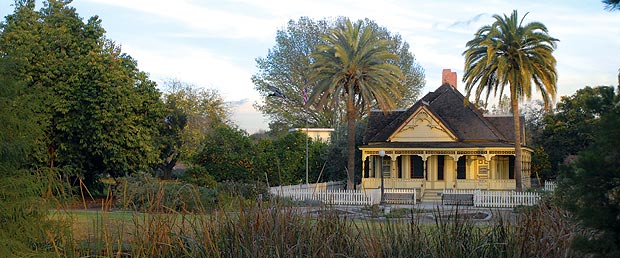
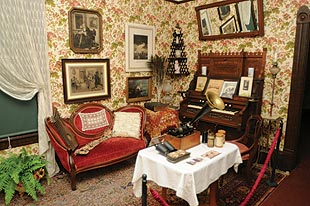 Top: Heritage House, built in 1874, originally stood on a downtown Fullerton corner.
Top: Heritage House, built in 1874, originally stood on a downtown Fullerton corner.
Right: The original owner of Heritage House, Dr. George C. Clark, built the Eastlake Victorian-style home for
his wife, Edith.
In 1972, the city of Fullerton planned to demolish an old house in the heart of the city for a street-widening project. Faculty wife Molly McClanahan and community volunteer Jorice Maag alerted the community and began a campaign to save the house and restore it. As a result, the house was trucked from its original site at the corner of Amerige and Harvard (now Lemon) avenues to the Fullerton Arboretum.
Dr. George C. Clark, who gave it to his wife, Edith, as a wedding gift, originally built the Eastlake Victorian-style home in 1894. He was Orange County’s first coroner and was among the first Fullerton city council members.
The house includes a parlor furnished with antiques, where Clark entertained. It is open from 2 to 4 p.m. on weekends and by appointment. Victorian Society volunteers in period dress lead two tours per month inside the Heritage House. “Third-graders in Orange County come here to learn about their heritage and local history,” Dyment said.
Victorian Christmas, held each December, features a dance and Victorian ladies dressed in proper 19th-century attire. Visitors wander through tableaus, or short plays, throughout the small house. Entering through the doctor’s door, they witness, for example, ladies discussing parties they’re about to attend or a patient who wants to improve his health. At times, someone portraying Dr. Clark can be seen.
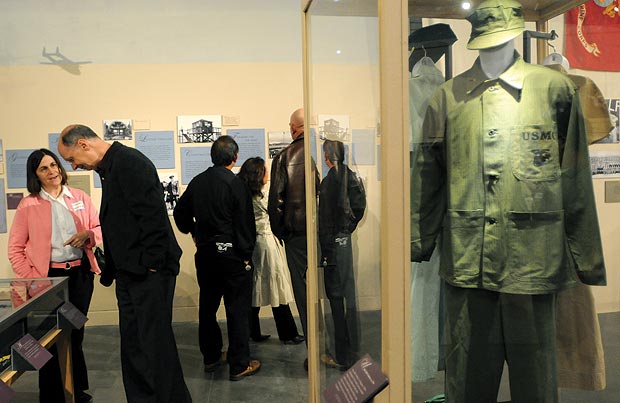
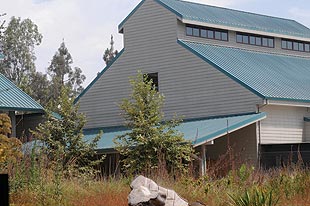 Top: The Orange County Agricultural and Nikkei Heritage Museum features exhibits related to county history.
Top: The Orange County Agricultural and Nikkei Heritage Museum features exhibits related to county history.
Right: Classes, meetings and other events take place in the visitor’s center.
The most recently built attraction at the Fullerton Arboretum is the Orange County Agricultural and Nikkei Heritage Museum, constructed in 2006 at a cost of more than $3 million.
The gray-and-white structure features exhibits highlighting the history and impact of agriculture in Orange County and showcasing the history and culture of Japanese-American farmers in local communities.
A city of Fullerton representative served on the advisory board that helped establish the museum. A city representative also sits on the governing board and the city contributes an additional $191,740 annually to the Fullerton Arboretum.
Currently, the museum is presenting its second student-produced exhibition, “Dirty Hands, White Gloves: Rethinking Gender in Victorian Orange County,” which runs through the end of 2010. An exploration of how local residents navigated ambiguous Victorian constructs of gender, the exhibit aims to show how class and rural locale softened strict expectations for men and women. The exhibition features select artifacts from Heritage House, focusing on how such objects tell both traditional and unconventional stories about Victorian gender roles.
“I love the idea of encouraging visitors to rethink that which they assume to be true about Victorian life in Orange County, but also to ponder artifacts as evidence of this life,” said Amanda Tewes, the graduate history student curating the exhibit.
“Farmers to Flyers: Marine Corps Air Station El Toro and Mid-Century Orange County,” the exhibit that ran through January, chronicled the air base from its beginnings as a farm owned by the Irvine family to the time it was decommissioned as an airbase in 1999. “We had photos and model planes that hung from the ceiling,” Dyment said. “They were put up by our students.”
“Farmers to Flyers” stemmed from a project begun in 2007 to report stories of people and their families who worked at MCAS El Toro. Their stories were tape-recorded and put on audio display. Additional displays featured the air station’s roots on the Irvine ranch, lima bean growing, farming technologies including the mobile thresher, and pilot helmets.
An inaugural exhibit, “Sowing Dreams, Cultivating Lives: Nikkei Farmers in Pre-World War II Orange County,” interpreted experiences of the Japanese-American farmers who settled and lived in Orange County in the years leading up to their relocation and internment in spring 1942. It covered immigration, family life, social organizations, and farming. This exhibit opened to the public on February 10, 2007.
Part of the museum is the Visitor’s Center, where classes from garden design to cooking are held in three classrooms, a pavilion that can hold up to 350 people, and a kitchen. “You can take classes that broaden your knowledge about the environment,” Dyment said. “We have composting, and we have a hypertufa workshop – it’s a type of pottery you’d make to put plants in. We have Vietnamese street food cooking, and we have yoga.” Classes for children include one titled “Arboretum Entomologists Bug Safari,” in which students discover insects and butterflies around the gardens.
Both the Visitor’s Center and the Orange County Agricultural and Nikkei Heritage Museum won awards for Best Overall Sustainable Design from the University of California/California State University Energy Efficiency Partnership Program. The awards recognize reduced use of natural resources during construction and ongoing energy conservation efforts throughout the life of new buildings and major renovations.
Green Scene Plant and Garden Show has been held each April since 1979. According to the arboretum’s website, www.fullertonarboretum.org, it is the county’s only major outdoor sales event focused exclusively on the home gardener, garden accessories, environmental education programs and products.
Last April, more than 80 vendors featured unique plants. Master gardeners, horticulturists and planting professionals offered landscaping advice. Volunteers included potters, educators, cultivators, nature guides, plant salespeople and museum docents. Arboretum volunteers as a whole donate a combined amount of approximately 24,000 hours per year.
June Bloom at the Potting Shed is another annual plant sale.
The Haunted Garden, held in late October, features ghouls and ghosts throughout the gardens to provide children with some fun scares. A costume parade, pumpkin patch tours and games are among the Halloween events.
Also in October is the Bonsai Show, which features the unique Japanese trees and tips on how to grow them.
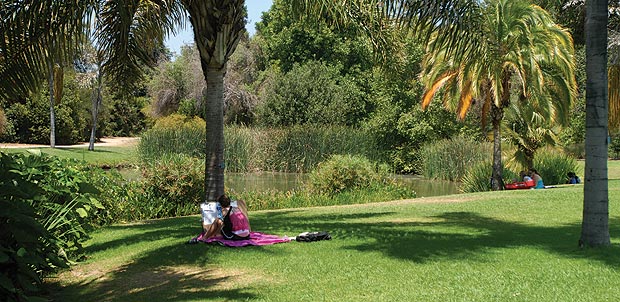
Art students are among the 120,000 annual visitors.
Since 1982, the Friends of the Arboretum has contributed services and funds and provided support for the Arboretum. “Our sole purpose is to provide volunteers for the arboretum and to raise funds,” said Mark Costello, Friends manager. “We provide a substantial amount of support.” Part of that support is development of the plant collection, which is purchased from specialty wholesale nurseries.
One of the Friends’ biggest fundraising events of the year is the Midsummer Night in the Garden Gala, held in July. Live and silent auctions take place, featuring prizes such as gift baskets, artwork and tickets to a ride in a Goodyear blimp. A gourmet three-course meal, a big band and dancing are part of the festivities. An annual award recognizes an individual who has contributed significantly to the arboretum. 